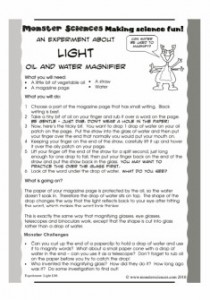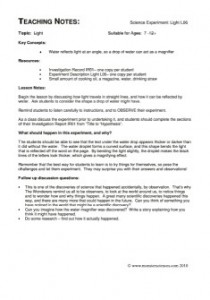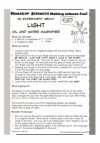Make your own magnifier using just oil and water, and learn how light can bend in the process.
 |
 |
Monster Sciences Light Experiment: Oil Magnifier
What you will need:
- A little bit of vegetable oil
- A magazine page
- A straw
- Water
What you will do:
- Choose a part of the magazine page that has small writing. Black writing is best.
- Take a tiny bit of oil on your finger and rub it over a word on the page. Be gentle – just dab, don‘t wear a hole in the paper!
- Now, here’s the tricky bit. You want to drop 1 drop of water on your oil patch on the page. Put the straw into the glass of water and then put your finger over the end that normally you would put your mouth on.
- Keeping your finger on the end of the straw, carefully lift it up and hover it over the oily patch on your page.
- Lift your finger off the end of the straw for a split second, just long enough for one drop to fall, then put your finger back on the end of the straw and put the straw back in the glass. You may want to practice this over the glass first.
- Look at the word under the drop of water. What do you see?
What is going on?
The paper of your magazine page is protected by the oil, so the water doesn’t soak in. Therefore the drop of water sits on top. The shape of the drop changes the way that the light reflects back to your eye after hitting the word, which makes the word look thicker.
This is exactly the same way that magnifying glasses, eye glasses, telescopes and binoculars work, except that the shape is cut into glass rather than a drop of water.
Monster Challenges:
- Can you curl up the end of a paperclip to hold a drop of water and use it to magnify words? What about a small paper cone with a drop of water in the end – can you use it as a telescope? Don’t forget to rub oil on the paper before you try to catch the drop!
- Who invented the magnifying glass? How did they do it? How long ago was it? Do some investigation to find out!
Teaching Notes: Light Science Experiment: Light L06
Topic:
Light
Key Concepts:
Water reflects light at an angle, so a drop of water can act as a magnifier
Resources:
- Investigation Record IR01– one copy per student
- Experiment Description Light L06– one copy per student
- Small amount of cooking oil, a magazine, water, drinking straw
Lesson Notes:
Begin the lesson by discussing how light travels in straight lines, and how it can be reflected by water. Ask students to consider the shape a drop of water might have.
Remind students to listen carefully to instructions, and to OBSERVE their experiment.
As a class discuss the experiment prior to undertaking it, and students should complete the sections of their Investigation Report IR01 from ”Title to “Hypothesis”.
What should happen in this experiment, and why?
The students should be able to see that the text under the water drop appears thicker or darker than it did without the water. The water droplet forms a curved surface, and this shape bends the light that is reflected off the word on the page. By bending the light slightly, the droplet makes the black lines of the letters look thicker, which gives a magnifying effect.
Remember that the best way for students to learn is to try things for themselves, so pose the challenges and let them experiment. They may surprise you with their answers and observations!
Follow up discussion questions:
- This is one of the discoveries of science that happened accidentally, by observation. That’s why The Wonderers remind us all to be observers, to look at the world around us, to notice things and to wonder how and why things happen. A great many scientific discoveries happened this way, and there are many more that could happen in the future. Can you think of something you have noticed in the world that might be a scientific discovery?
- Can you imagine how the water magnifier was discovered? Write a story explaining how you think it might have happened.
- Do some research – find out how it actually happened.



